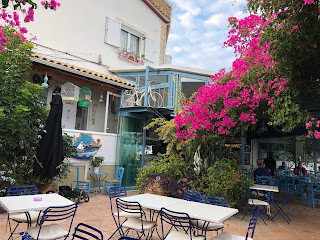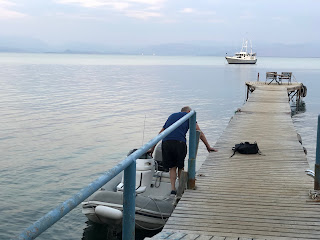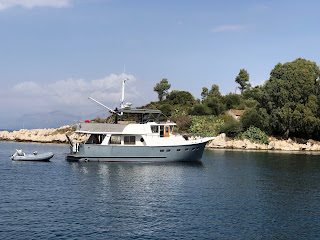Although the sale of Envoy was finalised late last year, the new Brisbane-based owners don’t plan to use her until they retire and part of our sales agreement was that we are able to still use Envoy this year.At the time we left Envoy we were inclined …
Archive | Envoy RSS feed for this section
THE MAGNIFICENT MARLBOROUGH SOUNDS
WHY SO MANY KIWIS AND AUSSIES CRUISE THE MED
WE MEET THE OWNERS OF STARLET
OUR LAST DAYS ABOARD ENVOY
ENVOY HEADS SOUTH FROM CORFU
Envoy anchored at Ormos Imerolia, northern Corfu with RHIB alongside jetty
This Selene trawler anchored nearby
This unusual “yellow submarine” came by with some tourists
Cruising around Corfu I hear a couple of knocking noises while under way and initially think the noise is caused by waves crashing against the hull. But it doesn’t sound right and we soon establish that the port side Naiad stabilisers are making a slight knocking noise when Envoy is in larger waves (much of the time it’s been too calm to need to use the stabilisers so we hadn’t noticed this issue).
They ask us to do some further tests by disconnecting the arm from the potentiometer that controls the stabiliser fin movement so that we could move the arm and therefore the fins by hand.
This replicates the issue without needing to go out into rough seas. Internaftiki soon advise that the problem is most likely one of the hydraulic valves and will come to Envoy, probably when we return to Lefkada. They also explain how to de-activate and lock the port side stabilisers while still using the starboard side. However we later find the knocking noise is still there, so it’s happening on both sides and we lock both fins in the central position and continue cruising in the reasonably calm conditions without our stabilisers.
Corfu has two huge castles known as the “old” (top) and the “new” (below), both viewed from Envoy
The sleek and fast USS Yuma
In season it’s often too crowded to anchor here but great at this time of year.
Here we meet some old cruising acquaintances – Britons Graham and Linda from the yacht Obsession of Poole as well as meeting a bunch of Kiwis aboard Mike and Heather’s yacht, Delightful Lady. Ashore a band plays live traditional Greek music until the early hours of the next morning serenading us to sleep.
Typical Greek fishing boat retrieving net
ENVOY CONTINUES CRUISING NEAR CORFU
ENVOY’S SALE COMPLETED
CRUISING WITH OUR FRIEND CHRIS
Envoy being launched at Lefkas Marina
Laurie enjoying a Greek Mythos beer and giant beans
Laurie and Chris by dinghy at N Ay Nikolau
Chris and Di at N Ay Nikolau with mobile taverna in background. They store all their beer outside with no security overnight and it’s still there in the morning
Dog on waveski
At many of these places wasps are a bit of a problem and I get a sting on my hand.
Yacht “A”
Chris and Laurie getting water before the watermaker was running
A classic looking motor boat at Agni
And a classic sailing ship
Mates enjoying a beer together
ENVOY IS CRUISING AGAIN
We departed Lefkas Marina on Friday morning and anchored in a bay off mainland Greece about 15 miles south. Weather is fine with temp in low 30s, little humidity and sea water a beautiful 28d. This was pretty fast progress seeing as we didn’t arrive he…








